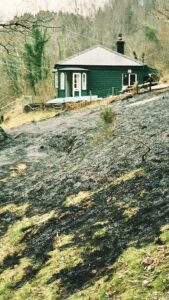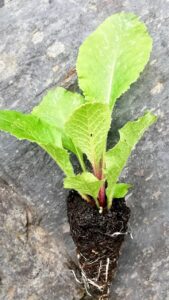In a dangerously overheating world, it’s more important than ever to keep it cool in our gardens and greenhouses.
Twenty years ago, my garden was on fire – or, more accurately, my garden-to-be was on fire. When I became keeper of this then bracken-riddled bank, I was on a new and exciting learning curve. I never imagined its start would almost burn my home down (our place is made, bar the roof, of wood).
Those flames flared in March. That spring was exceptionally dry for this part of Eryri (Snowdonia). The low creak and crackle of brown bracken fronds drying out after weeks of a rainless easterly should have been a clue. Learning carries risks; seconds after I’d set a match to the cardboard, the surrounding bracken was ablaze.

Flames licked out in all directions – some of the inferno as tall as me – feasting on the tinder-dry bracken and dried-out grasses that covered the bank. Billowing smoke muddied the clear blue sky. An outdoor tap existed only on a to-do list…
A headless chicken ran indoors to fill watering cans and buckets to douse the fire front threatening to lick at the cottage’s timber cladding. As those flames hissed and died, others leapt up the hill behind us, blackening and scarring oaks, eventually halted by fireproof green pillows of damp moss. Where flames met short green grass, they sputtered out. Water vanquished any smouldering pockets.
The bank that has become my terraced garden was charred, its fiery genesis branded on my memory. As the last wisps of smoke faded, a silver lining showed itself. The Great Burn, as I named it, cleared every bit of vegetation from the bank, revealing its contours; I saw exactly how the land lay, and a picture formed of how the terraces would fit in with the ground’s bumps and boulders, ups and downs. That picture became the garden I tend today.
I haven’t struck a match outdoors since.
My Great Burn was frightening, but it was barely a spark compared to the searing, record-breaking, life-threatening temperatures and vast, landscape-wide fires being fanned by snowballing climate heating. Our atmosphere now traps so much heat that even our seas and oceans are experiencing marine heatwaves (driving extreme weather events on land). Our unabated release of heat-trapping greenhouse gases is the planetary equivalent of shutting all the vents on a shade-free greenhouse on a cloudless midsummer day (you could try this at home – but only for a few minutes).
Visible from space, massive great burns are underway across our increasingly fractious earth. Colossal downpours sweep away communities, livelihoods and lives. Globally, we’ve just had the hottest week ever recorded. There are no silver linings in a time of what scientists call ‘dangerous climate change’.

Even before my embryonic garden became charred (here, nature quickly bounced back, bracken flexing its unfettered fronds over blackened earth), I was aiming to grow in ways that help to keep our world cool – gardening that’s earth-friendly, renewable, light, low-input and within ecological limits. I aim for self-sufficient, mindful gardening that gives back more than it takes from our living world. I strive – though sometimes fail – to leave the faintest of gardening footprints.
I’m blessed to be able to garden with renewable riches – from copious leaf mould and green wood chips, which not everyone has, to one that we all do: sunshine. Free, limitless and non-polluting, only modern sunshine powers my unheated greenhouse, the nub of my climate-cooling efforts. It’s here that I sow, pot, root and coddle plants destined both for my garden and to help heal the wilder, sheep-mown hills around my home. Dahlias rub shoulders with burdock, cosmos with coltsfoot, pea shoots with wild primroses, sunflowers with sessile oak.
Primroses are this summer’s jewel in my garden’s modest climate-cooling crown. I grow them from seed collected locally, some just footsteps away, others within a half hour’s walk (the seed-pods are ripening now). Seeds sown last summer came up like mustard and cress this spring.
I moved the seedlings into multi-celled trays (with 20-plus years of service), filled with peat-free compost. I used a reliable, quality SylvaGrow mix, alongside a 50:50 DIY blend of my own leaf mould and garden compost. Both mixes are nurturing strong, healthy plants; there’s no visual difference between them. But some of my Primula vulgaris are cooler than others.
Filling trays with the bought compost was the end of a long energy- and resource-intensive chain (the same would apply to any quality peat-free). The compost’s ingredients (wood bark/fibre, coir, fertiliser) had to be sourced/made, transported (by road and sea), mixed and bagged, then conveyed again to gardening retailers (off and online) on pallets, wrapped in plastic.

For the final leg of the journey to our gardens and greenhouses, the compost will have hit the tarmac once more, in car boots or delivery vans. There were other inputs along the way: packaging/printing, advertising and so on. Gardening miles were clocked up. Greenhouse gases were set free. After coaxing out the last crumbs, we’re left with a plastic bag (made from oil), although that is reusable and theoretically recyclable.
Filling trays using my DIY blend was the final act in a short, low-input chain. Leaves fell from the sky, I raked them up, then time, plus microbes, turned them into leaf mould. Ditto with garden compost: I piled up the raw materials, and life forms both unmissable and invisible broke them down.
Footsteps away, I blended the end products together (a decent workout), and my primroses romped away. No fertilisers, no packaging, no vehicle fumes, no incoming plastic bags (empty ones are reused to store my oh-so-cool potting mix). No gardening miles. No cost. An odd weed seedling, but barely a toeprint.
Cool plants, grown in a garden born in fire; my small, cooling contribution to an overheating world. Earth-friendly. Renewable. Light and low-input. Doable within ecological limits. Self-sufficient, mindful gardening that gives more than it takes from our living world. It’s what sets me on fire.
Text and images © John Walker
Find John on Twitter @earthFgardener










